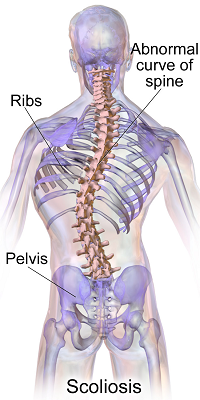What is Scoliosis? Its Causes, Images, Symptoms, and Treatments
Scoliosis is a medical term which literally means deformed or crooked spine towards one side. This technically means lateral curvature of spinal column towards one side. Truly speaking, this is a three dimensional deformity with the vertebral column tilting to one side, bending either forwards or backwards and rotating towards one side.

What causes scoliosis?
This entity is present in two broad age groups one less than 18 years and other above 60 years. The most common variety is found in the adolescent age (10-18) more commonly in girls where the reason of deformed spine is not known, so this is labelled as Idiopathic Scoliosis. This kind of scoliosis which is there for no visible cause can be found in early age groups where it is labelled as Infantile Idiopathic scoliosis if its detected within first three years of life or Juvenile Idiopathic Scoliosis if its detected between 3-10 years of age. These are less common than the Adolescent variety of Idiopathic scoliosis.
The second most common variety is congenital scoliosis where one side of the vertebral column is either not fully formed or fully separated which leads to differential growth of spine in the growing years thereby presenting as tilting of the body to one side. The other causes of scoliosis can be Neuromuscular due to weakness of muscles as in Cerebral Palsy or Poliomyelitis. The Scoliosis in the old age is due to differential degeneration of the disc or facet joints in spine leading to tilting of the vertebral column to one side.
Since the cause based division of various types of scoliosis did not have any implication on the treatment, the scoliosis was further divided into two major types, one that is detected before 5 years of age known as Early Onset Scoliosis and the other after 5 years of age known as Late onset scoliosis. This has a lot of bearing on the treatment as the lung development takes place in first 5 years of life and if we do a traditional spine surgery in less than 5 years of age for scoliosis, this can lead to catastrophe and early breathing problems to the child.
Symptoms
The biggest problem of scoliosis in our society is diagnosis and reaching a spine specialist who can guide the parents about the right path. Because its a slow change in body shape, it takes 2-3 years before parents or child can identify that there is some problem in the body shape. Even noticing the change in body shape, majority of the people or general physicians miss this entity and falsely console the parents that as long as there is no functional impairment, this problem can be ignored. This leads to late diagnosis which can make the problem worse.
These next few thing will help you screen your body for any deformity in spine. Every parent should see their children or ask their adolescent children to see themselves in the mirror without upper body clothes once every 6 months to see whether Both their shoulders are at the same level or different level. This can be the key to early identification of the problem. Any asymmetry in the back or chest or pelvis can give a clue to the underlying problem. As this is a cosmetic problem in majority of the children, its usually missed as the child is playing around with no functional disability.
Treatment
The treatment for this is simple, once identified. A full length spine x rays and a few other tests as per the spine specialist helps in finding out the cause of scoliosis. This can help predicting how fast this deformity or change of body shape is going to progress or increase as the child grows. This helps us decide whether the problem is going to be wilfully ignored, treated by serial plasters, a brace or treated by surgery.

There are broadly two ways of surgical treatment for patients with scoliosis. One is operating the spine by fixing and fusing all involved levels in spine which is a definitive surgery to be done after 5 years of age at the best possible age as per your spine specialist. Other way is to do a limited fixation without fusing the spine which can lead to a limited increase in the deformity so that the chest and lung growth is not hampered.This is not a definitive surgery and will require a definitive surgery at an adequate time as per your spine specialist. All of the surgeries are done with the assistance of Neuromonitoring which helps in controlling the amount of correction without damaging the power in legs of the patient.
The take home message is to identify the problem early so that this can be managed at the earliest possible stage with minimal intervention as possible. Even if this requires a surgery, an early surgical intervention has a lot better long term results in comparison to a delayed treatment.